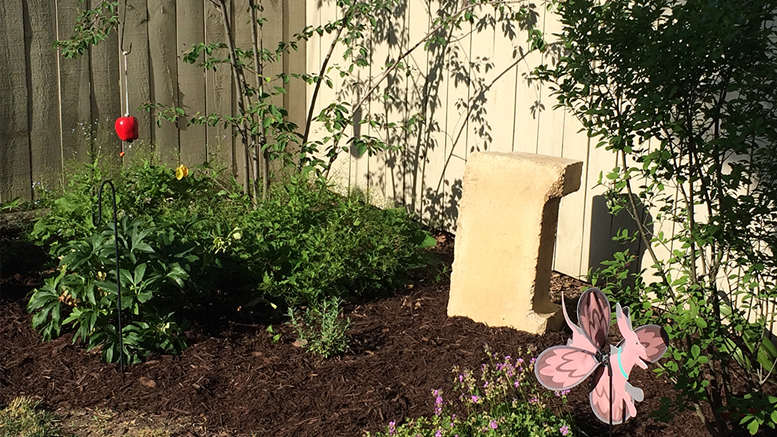By: John Carlson—
The distinctive monoliths rise from barren soil. Primitive yet precisely planned, they are the labors of a people long since lost to time, gigantic rocks raised in praise of ancient gods and goddesses before whose cosmic countenances men worshipped in awe.
Stonehenge?
Nah, my backyard.
The sandstone blocks began showing up out there when we started planting our butterflies, birds and bees garden. Our long-suffering gardener, Mary Beth Lambert, would pierce the soil with a spade, then strike a block with a metallic clink!
So working together, we’d remove them. Her job would be to dig around the heavy blocks in the blazing hot sun, rocking them back and forth in endless imperceptible increments until they finally loosened. Then she’d brace herself against the ground and, gasping for breath, heave them to the surface. Meanwhile, my job was to call out encouragement like “You go, girl!” while fanning myself on our back deck and making sure the ice in my sun tea hadn’t melted yet.
It felt great to help.
So where did those blocks come from?
They looked like leftovers from the movie “This Is Spinal Tap.” You know the scene where the band’s concert set designer tries to recreate Stonehenge on stage for their album of the same name? Unfortunately, he forgets whether one little slash or two little slashes stand for feet or inches, and screws up his diagram. Consequently, when the fake Stonehenge monoliths are dramatically lowered during the band’s opening number, the guys are stunned to see that instead of 18 feet tall, they stand just 18 inches. To give things some measure of perspective, the designer hires dwarfs to play the earnestly dancing Druids.
My blocks look kind of like those.
Still, I doubt that props from “This Is Spinal Tap” somehow ended up in my backyard. Could our blocks be real monoliths? That and the notion actual Druids once danced around in my own backyard seem pretty iffy. Why would Druids want to come here anyway? Having looked up “Druids” on Google, I now know they were real big shots back home in Celtic society, “the adjudicators, the legal authorities, the lore-keepers.”
If I had any Celtic ancestors, they were most likely the public toilet-keepers, bathroom attendants who hung around the peat bogs snacking on dragonflies snatched from the air, when they weren’t sleeping off hangovers.
Guys like that don’t raise monoliths. Not even little ones.
So my sandstone blocks also probably aren’t leftovers from an ancient Druid offshoot that wound up living in what would eventually come to be known as “Funcie.”
These blocks do lend a mysterious air to our garden, though. We’ve even had respected lawn professionals examine them. They can’t figure how the heck they got buried out there, nor why they got buried out there. What’s more, making all this personally intriguing is the fact that one of the blocks is sort of shaped like a “C” – presumably for Carlson. It’s as if our move to this house nearly four years ago was somehow pre-ordained by dark forces, like in horror movies.
Spooky? Kinda.
But we have gotten used to these blocks. We have even grown fond of them. They make a great base on which to place our statue of a little farm boy wearing a straw hat while fishing. They are also great for plugging holes the dogs dig under our fence, in their quest to find new masters who spring for bacon-flavored Beggin’ Strips instead of stinkin’ dog biscuits.
And truth be told, as a domestically challenged homeowner who doesn’t know a pergola from a gazebo, and couldn’t identify a soffit if one reared up and bit me where I sit, I have come to appreciate telling inquisitive people exactly what those things are.
“What are those things?” they ask.
And I answer, “Blocks.”
This is in direct contrast to people who observe the exotic variety of attractive greenery that Mary Beth has blooming back there now and ask me, “What are all those interesting growths?”
The answer I always offer is, “Um, plants?”
A former longtime feature writer and columnist for The Star Press in Muncie, Indiana, John Carlson is a storyteller with an unflagging appreciation for the wonderful people of East Central Indiana and the tales of their lives, be they funny, poignant, inspirational or all three. John’s columns appear on Muncie Journal every Friday.



